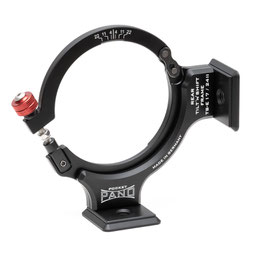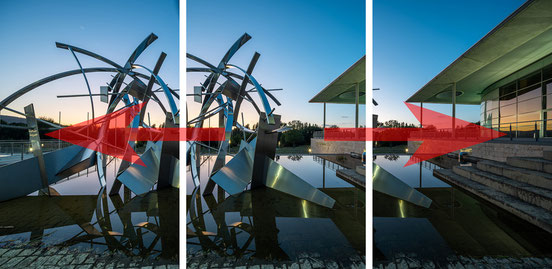Shift Panoramas - Examples
Here are a few examples to show you what kinds of panoramas can be realized with the Rear Tilt 'n' Shift Frame and the TS-E Panorama Head.
Using the REAR Tilt 'n' Shift Frame
The Rear Tilt 'n' Shift Frame can be used to create different types of shift panoramas. You can distinguish the shift direction and the orientation of the
camera.
Up & Down Shift in landscape mode
Here, the lens is set up (the setting of the two axes of rotation of the lens) so that the shift is in the vertical direction (up-down) and the camera is in landscape mode. Due to the large shift of up to 11mm, it is advisable to create shift panoramas of 3 images (center, 11mm up, 11mm down) to ensure enough overlap between the frames.
Up & Down Shift in portrait mode
Here the camera is shifted also up and down, but with the camera in portrait mode. This results in an extremely large vertical angle of view, which is suitable for fully imaging tall and narrow objects.
left & Right Shift in Portrait mode
In the following example, the shift mechanism was rotated 90 degrees so that it can be moved to the left and right. The camera is oriented in portrait mode.
Left & Right Shift in Landscape mode
The largest horizontal angle of view is achieved by lateral shifting while the camera is in landscape mode.
Using the TS-E Panorama Head
The TS-E Panorama Head offers the possibility of turning the lens around the nodal point (indicated by the green arrows) in addition to the shift mechanism (indicated by the red arrows). This allows a horizontal angle of view of up to 360°.
Here, a panorama is shown in which the camera was in portrait orientation and two rows were photographed using the TS-E Panorama Head (one row shifted up, one row shifted
down).
The rotation around the entrance pupil resulted in an enormous horizontal angle of view (about 200°). This can no longer be represented as a classic wide-angle shot in rectilinear projection.
Therefore, a spherical projection was chosen for the example shown above.
Of course, panoramas are also possible in which only one row is recorded (rotation with TS-E Panorama Head, with or without additional shift).












